Antlers are great. But at the end of any hunt, a cooler full of wild game meat is a heck of a trophy. When it comes to preparing your wild game for the table, one of the biggest topics of discussion is how to age your wild game – or when it’s even beneficial.
As you consider whether you should age the game meat from your next hunt, here are some quick ideas that we have learned along the way…
Start With Clean Meat
The first thing you should do when you get home with any venison or skinned wild game, is to wash the quarters or the carcass in a cold water and vinegar solution and then pat it dry. Just add a little bit of distilled white vinegar to a bowl of cold water. Then use a clean rag to wipe down the meat. Vinegar is naturally anti-bacterial and this process will remove any hair and dirt without leaving any taste on the meat.
Once the meat is clean, use another clean rag to carefully pat it dry. Once it’s clean and dry, you’re ready for aging and processing.
The 24-Hour Rule
After harvesting a big game animal, you should wait at least 24 hours, if not 48 hours before processing whenever possible.
This actually has nothing to do with aging. It has everything to do with the animal passing through rigor mortis. Usually within a few hours after an animal dies, the body will become stiff and rigid. This is called rigor mortis. It usually lasts somewhere between 24 and 48 hours. And it’s best to let the carcass pass through this stage before you begin processing.
If you begin cutting meat off the bone before or during rigor, the muscles will contract with no bones or other structures to hold them in place. This contraction causes what’s called “shortening” and leads to tough meat.
Of course there are times when deboning an animal immediately is necessary and can’t be avoided. In these situations, just be aware of that outcome and plan accordingly. Ground meat and slow-cooked recipes are excellent for those tough cuts of meat.
This 24-hour rule is one reason that we prefer to pack out bone-in quarters whenever possible. However you pack out the meat, whether it’s deboned, quartered or whole, be sure to use high quality, breathable game bags to protect the meat during transport. Clean, dry and plenty of air circulation are critical elements for great-tasting game.

WHICH WILD GAME SHOULD BE AGED?
Game Birds
The one that everyone seems to agree on is wild birds. In fact, many chefs consider the aging of game birds to be absolutely necessary. Pheasants, ducks and geese all benefit from aging. Aging birds significantly improves tenderness and flavor. And, it makes them much easier to pluck as the feathers loosen during the aging process.
Game birds can be aged whole, with the feathers on and the guts inside. If the bird has been gut shot, then it may be a good idea to remove the insides before aging. Otherwise, they can be aged completely as-is. Birds should be aged for at least a couple of days. Many hunters seem to agree that a week is ideal for birds like ducks, geese and pheasants.
Aging is easy – they can be hung in a consistently cold garage or shed. In the absence of those options, they can even be kept in the crisper of your refrigerator at home. On several occasions, I’ve simply placed a few ducks or pheasants into a brown paper grocery bag and stashed them in my fridge for a week.
Red Meats
Other than game birds, the other wild game animals that can benefit from aging are those with red meat – deer, elk, moose, antelope, sheep, etc. Even then, not every piece of a deer benefits from aging. In large part, it depends on how you intend to prepare it.
Cuts that will be ground or made into sausage do not need to be aged. And any cuts that you intend to slow-cook or braise do not need to be aged. The aging process develops tenderness (and to some extent flavor, depending on how long you age). But when that meat is destined for the grinder or the crock-pot, any advantage of tenderness is a moot point anyway.
The best cuts for aging are usually those whole muscle roasts that you intend to roast or smoke. As a good rule of thumb, if you’d cook it to medium-rare then it’s probably a good candidate to be aged. The tenderness and flavor will be well worth the effort.
The exception to that rule can be tenderloins and small backstraps (those from a small doe, for example). Of course tenderloins are very tender anyway. Plus, dry aging does incur a small amount of meat loss when you trim off the rind. On those pieces of meat that are very small to begin with, it’s probably not worth the loss.
Cuts like the backstraps, whole muscle roasts like sirloins, and even whole hindquarters are great pieces to age.

Mule Deer Backstrap, Dry Aged 2 Weeks
HOW TO AGE WILD GAME?
As mentioned above, birds are easy. They can simply be hung whole in a cold place or kept in a refrigerator. Big game animals like deer and elk can be a bit more of a challenge.
First, it’s important to mention that there are two ways to age red meat. Dry aging requires cool temperatures and air circulation around the meat. Wet aging can be done in a vacuum-sealed bag in the fridge. Both of these options contribute to the tenderness of the meat. The advantage of dry aging is that it offers results in bot tenderness and flavor. While wet aging won’t develop the flavor of the meat, its advantage is that it’s easier if you have limited space to work with.
To wet-age red meat, you can simply place vaccum-sealed bags in your refrigerator for several days, a week or more in your fridge before you put them in the freezer for long-term storage. You won’t develop any of that dry-aged flavor. But it will result in more tender cuts of meat.
Dry-aging is a bit more cumbersome – but it’s totally do-able at home for most people and it can yield great results.
If you come home with a whole carcass and you have the space in a consistently cold garage or shed, you can hang the whole thing for a week or more. Before aging, simply remove the tenderloins, neck meat, and anything else that’s not a good candidate for aging. If you intend to grind the rib meat and front shoulders, you can go ahead and remove those too. By leaving the hindquarters and the backstraps on the carcass, you reduce surface area and you’ll maximize your meat yield.
While aging, keep that carcass covered in a clean, Full Carcass Game Bag. Not only will it protect the meat from dust, dirt, bugs and other contaminants, but it will also keep the meat from excessive drying.
If you’re not able to work with a whole carcass, you still have options. On most of our backcountry hunts, we bring home the animals quartered. When that’s the case, you can hang the hindquarters in a cold garage or shed. If that’s not an option, you can dry age red meat in a refrigerator or cooler. Either way, keep the quarters in clean game bags throughout the aging process. Again, this will protect the meat and prevent excessive drying.
The key to dry aging meat in a fridge, is air circulation. The meat will need to be on a wire rack or suspended to allow air to circulate around all sides. With a small animal like an antelope or small deer, you may be able to dry age an entire hindquarter this way. With an elk, that’s probably not an option. You’ll need to separate the hind leg roasts like the sirloins to dry age individually on wire racks. If you go this route, flip the roasts daily to keep air circulating evenly on both sides.
At a minimum, it’s usually pretty easy to dry age the prime cuts – backstraps, sirloins, etc. on wire racks in the fridge.

Removing the Dry "Rind" From a Dry Aged Backstrap
HOW LONG TO AGE? AND WHAT’S NEXT?
Most venison and similar red-meat wild game can easily be aged a week or two at home without special equipment. Going beyond that is certainly possible. But then carefully monitoring temperature, humidity and tightly controlled conditions is much more important. Additionally, it just takes some common sense. As you age meat, keep a close watch on appearances and smell. Properly aging wild game meat should smell good and it should have a nice, dark rind covering the meat.
I have regularly hung hindquarters and aged backstraps on a wire rack in the fridge at home for up to two weeks very successfully. But again, use your best judgment based on temperature, conditions and observations.
When it’s finished aging and you’re ready to package the meat for long-term storage, place the meat on a clean cutting board. Using a very sharp filet knife, trim the dry rind from the outside of the meat. But don’t throw it away! If you plan to make any burger or sausage, this rind is an excellent flavorful addition to your ground meat.
Once the rind is trimmed away, you can vacuum-seal or wrap the cuts in butcher paper just like you normally would. Then label and keep them in the freezer for storage. Or even better, enjoy some of this outstanding meat before it’s frozen!
Ready to learn more about meat processing at home? Check out our previous series on wild game processing:
Part 1: Equipment and Getting Started
Part 2: Breaking Down a Hindquarter
Part 3: Shoulders, Backstraps and More
And be sure to take a look at the meat care accessories that we have in the Caribou Gear Store. These are the essentials that we use on our big game hunting adventures. Have questions? Please don’t hesitate to reach out. And best of luck on all of your upcoming hunts!

By Ryan McSparran
Ryan is a hunting guide based in Colorado, and is proud to be a part of the team at Caribou Gear.

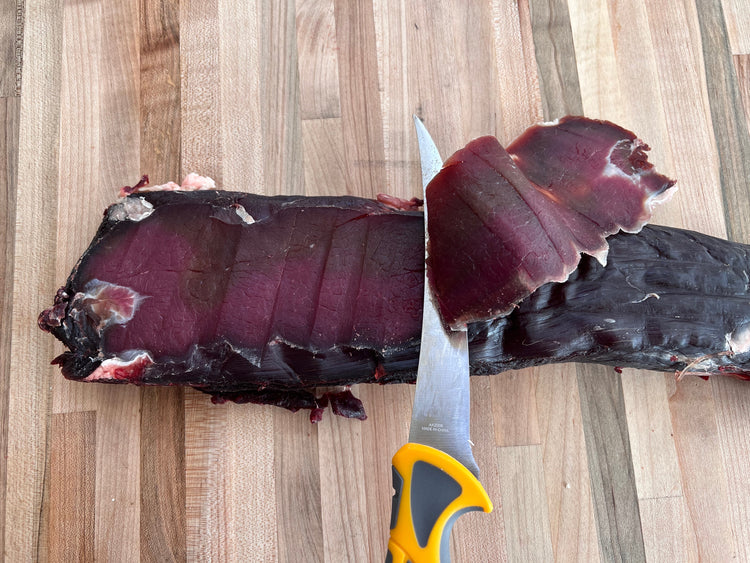






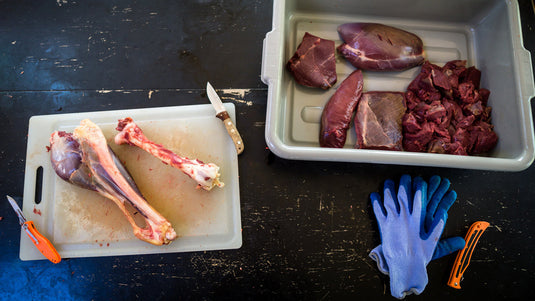
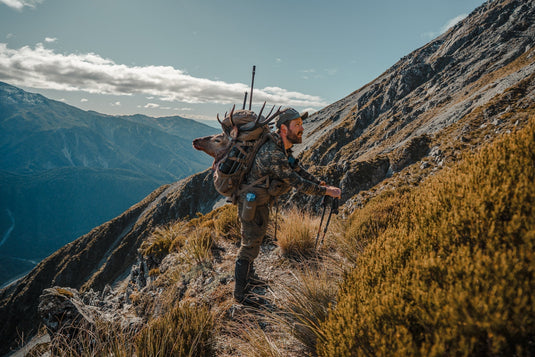
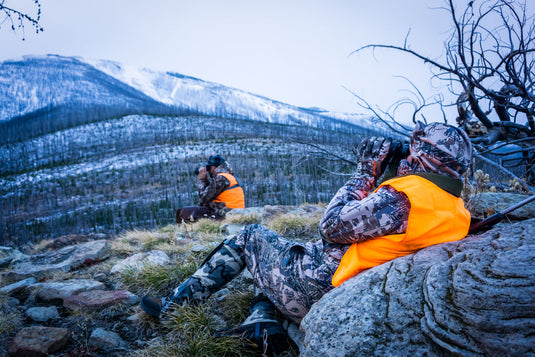
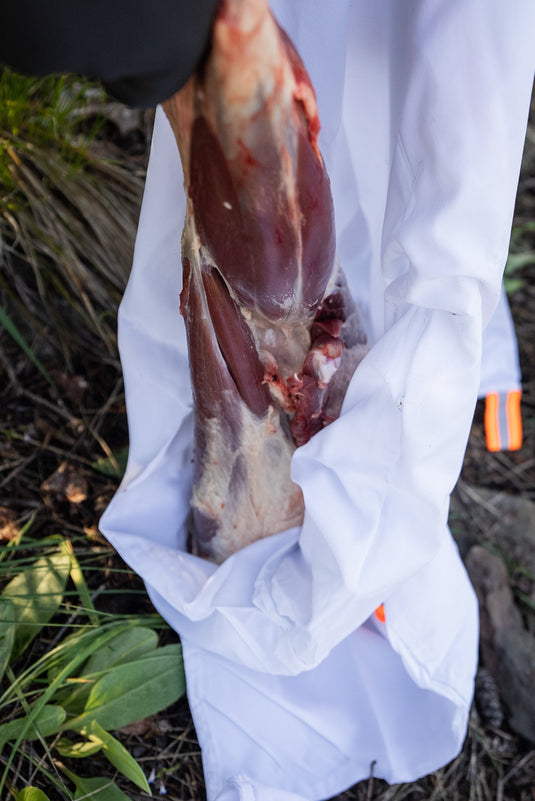
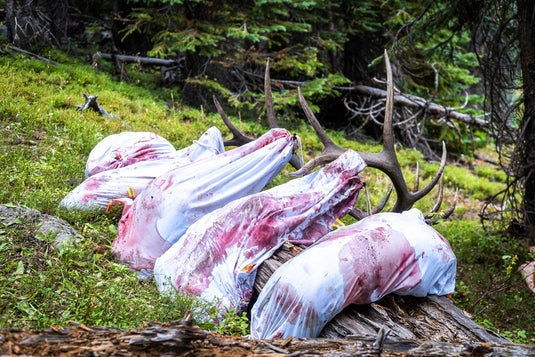
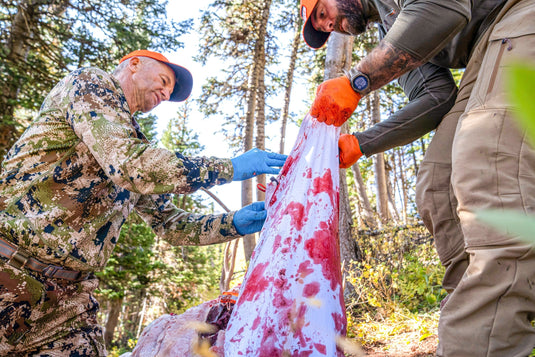
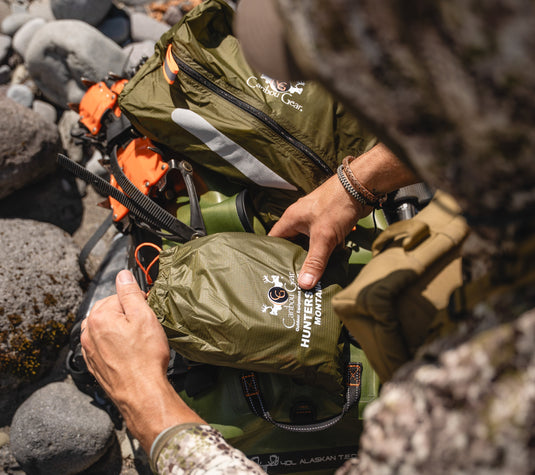
Great pointers on aging meat. Wild game is good for the soul!!!